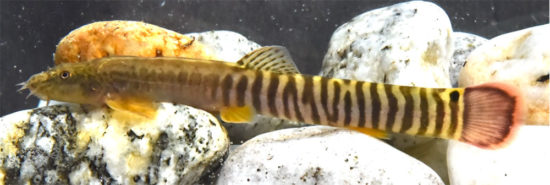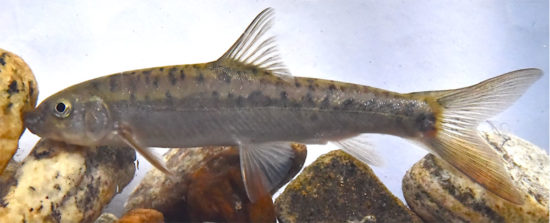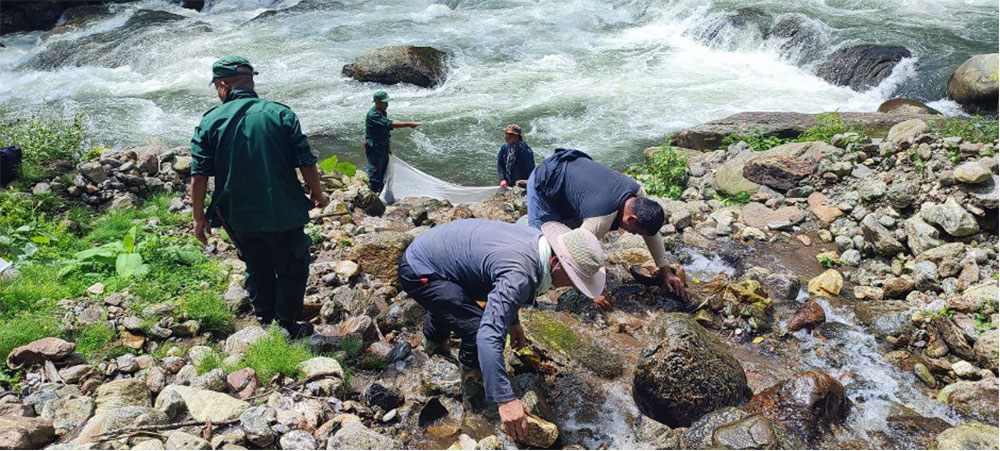Plant and animal species in water, their habitats, and the interaction between them together can be called aquatic biodiversity. The rivers and stream networks across Bhutan could potentially host diverse aquatic biodiversity given a wide range of habitats from the Himalayan foothills to permafrost and freshwater lakes among the mountain peaks over 7000 meters above sea level. The recent research on aquatic diversity led to the discovery of a new species such as the new dragonfly, which was named ‘Gyalsey Emerald Spreadwing’. This article explores what we know about Bhutan’s aquatic diversity and proposes a way forward for improving knowledge and management of aquatic biodiversity.
Aquatic biodiversity plays a key role in ecosystem functioning. For example, larger water-dependent animals like White-bellied Herons or Golden Mahseer thrive on the richness of aquatic biodiversity. However, to ensure the successful conservation of those species, improving our knowledge of aquatic biodiversity is necessary. For instance, the reduction in the average weight of polar bears in the Canadian arctic was attributed to less availability of prey populations like penguins. The penguin population, in turn, was found to be reduced due to low the population of density of aquatic bugs affected by the warming climate.


Aquatic bugs ubiquitously referred to as “macro-invertebrates”, are a significant food source for many fish and other water-dependent species. Changes in the organism associations are often monitored for signs of a problem in their ecosystem. Macro-invertebrates live in freshwaters such as lakes, streams, and rivers for part or entire life cycles. Macro-invertebrates thus form an integral aspect of every aquatic ecosystem as the foundation of the food chain. Disturbances to their population can negatively affect the community structure often leading to the collapse of entire ecosystems like to collapse of the cod fishing industry in Canada. Not only do they serve as major prey species for crustaceans, amphibians, and water birds, but they are also involved in the breakdown of organic matter and nutrients, thereby cleaning the water.
Conducting research and gathering data on aquatic bugs are also key to minimizing public health risks through contamination of drinking water or contamination of mineral springs (locally referred to as ‘Menchus’) and hot springs (locally referred to as ‘Tshachu’). A sample of all aquatic life stages of macro-invertebrates, such as mayflies, stoneflies, and some caddisflies, are often used as an indication of water quality because some are sensitive to pollution, habitat changes, and severe natural disasters – especially the members of Ephemeroptera, Plecoptera, and Trichoptera. The number of tolerant organisms to the number of intolerant organisms is often used as an index to measure and interpret water quality. A high number of pollution-tolerant organisms and a small number of intolerant aquatic bugs may indicate poor water or habitat quality. Further, understanding the biology of the bugs would be important in the management of water-dependent culturally significant places like Neys (e.g. Limestone karst systems of Rangtse Ney) and freshwater lakes (e.g. Buli Menmo Tsho).
Aquatic biodiversity also plays a significant source in the global food industry. In Bhutan, communities like Brekha in Zhemgang, Rukha-Samthang, and Lawa-Lamga in Wangdue Phodrang are heavily dependent on income generated through fishing in wild rivers. The livelihood of those local communities is heavily dependent on an abundance of aquatic biodiversity which is not well studied. Notably, healthy aquatic biodiversity also has the potential for lucrative businesses such as caviar gold through raising sturgeon fish in clean freshwater ecosystems. Further, healthy freshwater in itself is the source of a healthy population and resilient economy. Thus, how well we know our aquatic biodiversity is critical for public health, culture, and economy.
Scientists from the College of Natural Resources Dorji & Gurung (2017) in their book titled ‘Aquatic Biodiversity of Bhutan’, mentioned that as of 2017, Bhutan has recorded 109 species of fishes, 89 families of macro-invertebrates, 36 aquatic plant species, 27 species of phytoplankton, 49 species of zooplankton, two freshwater shrimps and five species of freshwater crabs. However, the diversity of freshwater molluscs, mesofauna, and meiofauna was found limiting. It is surprising that knowledge of planktonic diversity is still based on one of the earliest planktonic studies conducted in Trashiyangtse by Sharma & Bhattrai in 2005. Nevertheless, freshwater biodiversity has made significant contributions starting with pioneer limnologists like Dr. Bhattarai who first recorded 52 fish species in 2005 to 109 fish species as of 2015. In 2018, five new fish species have been described bringing the total number of fish species to 114. Recently the National Research Centre for Riverine and Lake Fisheries accounts that Bhutan has recorded 124 fish species.
The increasing level of threats to unknown aquatic biodiversity further risks losing the country’s biodiversity resources. Dorji & Gurung (2017) enlists threats to Bhutan’s aquatic biodiversity, which include climate change, nutrient enrichment, hydrological modifications, overexploitation, habitat modification, pollution, and the spread of invasive species. Research has shown that rising temperature also threatens cold-blooded animals like fish, reptiles, amphibians, and insects, which comprise more than 99% of animals on earth. The body temperature of these animals reflects outside temperatures – so they can get dangerously hot during heat waves. Such research outcomes should serve as a warning to our aquatic biodiversity. How could we measure and understand the threats to our aquatic biodiversity if our knowledge and understanding are limited? The team of water research scientists thus presents directions for future research in improving our knowledge and information on our aquatic biodiversity. Bhutan’s immediate focus should be:
Improving information and knowledge on aquatic biodiversity and its biology from various habitat types. For example, the whole Gasa Tshachu area would be harbouring sulfur-dependent bugs unknown to current science, or there could be unique hot-water tolerant bugs in the hot springs. Data collection should be beyond taxonomic enumeration and for understanding their ecology and biology as recommended by Dorji & Gurung (2017). For instance, the effects of rising temperature on Bhutan’s water and water-dependent ecosystem needs urgent attention.
Exploring the application of aquatic biodiversity as ecological indicators for water quality and health of water-associated ecosystems. Such applications open an opportunity for the incorporation of scientific principles in the management of important water-related cultural sites like Tshachu, Menchu, and freshwater lakes. Similarly, such information would be critical for the environmental management standards of other water bodies to understand the impacts of hydropower and other major infrastructure development on water bodies.
Understanding the risk of aquatic biodiversity to public health is critical. For example, the presence of blue-green algae in small ponds inside caves or eutrophic open freshwater lakes considered ‘sacred’ by locals might pose a risk to public health. Similarly, the abundance and risk of aquatic biodiversity to portable water supply for domestic consumption needs to be explored.
Realignment of conservation goals for charismatic species like White-bellied Herons or Golden Mahseer is necessary. The conservation programs and projects should adequately address threats and explore opportunities for sustainable management of aquatic biodiversity, as planktonic diversity plays a key role as the primary producer in the ecological supply chain.
Gathering local knowledge from communities with a long history of fishing should receive similar priority as other fields of research. The local elderly population would hold a reposition of historical changes observed to their rivers and associated ecosystems.
The article is published based on personal experiences and observations by a group of water researchers from Bhutan. The group can be contacted at waterresearchbhutan@gmail.com


